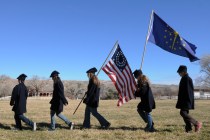Visitors can explore historic buildings in Jerome
Arizona's largest ghost town, old Jerome, invites visitors to explore shops, galleries, eateries and other attractions housed in rehabilitated historic buildings along its steep streets. Once one of the state's largest towns, Jerome gained a wicked reputation more than 100 years ago. The 15,000 residents living there in its heyday included disreputable characters attracted to Western boomtowns.
Jerome sits astride Highway 89A halfway up Mingus Mountain between Prescott and Sedona, about 285 miles from Las Vegas. Plan about six hours of driving time, following U.S. 93 to Kingman, Ariz. Head east from Kingman on Interstate 40 to the junction with Highway 89A at Ash Fork. Those towing trailers more than 20 feet in length should not take the winding road down Mingus Mountain. Alternate routes include linking roads from Prescott or Sedona.
Jerome's precarious, mile-high perch on the mountain could only have been deemed suitable for a mining town. The steep angle necessitates carving terraces for the highway and streets with cantilevered supports for the hairpin turns. Buildings at street level usually have scaffolding or stilts holding up their downhill sides. Such unusual construction creates a picturesque setting for the town, which commands arresting views over the beautiful Verde Valley.
Jerome's origins lie in rich mineral deposits, principally copper, first mined by native people and noted by Spanish explorers before modern development began in 1876. Original claim holders sold out to United Verde Copper Company in 1883. The developing camp took the name of its principal financial backer, a relative of Winston Churchill's American mother, Jenny Jerome. High shipping fees and operating costs forced failure after two years.
The financial backing of railroad and mining magnate Sen. William A. Clark breathed new life into the little city. Soon a narrow gauge railroad took the ore down the mountain for processing and shipment by way of a connection to a main line. By the turn of the 20th century, Jerome was Arizona's largest copper producer.
New resident James S. Douglas, experienced in copper mining, developed the Little Daisy Mine, a main producer. Douglas built an adobe mansion just below the town in 1916. Jerome's mines produced copper badly needed during World War I. Production peaked in 1929, just before the crash that brought about the Great Depression and an end to Jerome's flush years.
The Little Daisy closed in 1938. The United Verde, under the Phelps-Dodge Corporation, produced less each year until it closed in 1952. Fewer than 100 residents remained. Fire, vandalism, climate and gravity took their toll on Jerome's abandoned buildings. Jerome easily could have ceased to exist.
The local history society saved many buildings. An infusion of urban refugees in the 1960s and '70s staved off extinction. Residents rehabilitated venerable structures to house artists' workshops, galleries, shops, bed and breakfast inns, hotels, restaurants and other businesses that drew tourists. The Douglas Mansion became Jerome State Historical Park in 1965. The whole town was named to the National Register of Historic Landmarks in 1976.
Jerome's revival continues despite closure of the state park this year because of the present difficult economic times. The mansion was overdue for repair of a failing wall, so Arizona park officials closed the park at least for a few months. A few other state historical parks now closed include Homolovi Ruins, McFarland and Oracle. Some Arizona parks remain open on five-day schedules, closed Tuesdays and Wednesdays. These include Fort Verde, Riordan Mansion, Tonto Natural Bridge, Tubac Presidio and Yuma Territorial Prison. Yuma Quartermaster Depot is closed on Sundays.
Closure of many of Arizona's 23 state parks announced last year alarmed several rural communities dependent upon tourist revenue related to the popular attractions. They launched fundraising campaigns and reached into their own pockets to make up some of the shortfall. Arizona State Parks continues to work with cities and counties across the state in unique management and financing arrangements to keep the parks open. Check park status at azstateparks.com.
Margo Bartlett Pesek's column appears on Sundays.

















